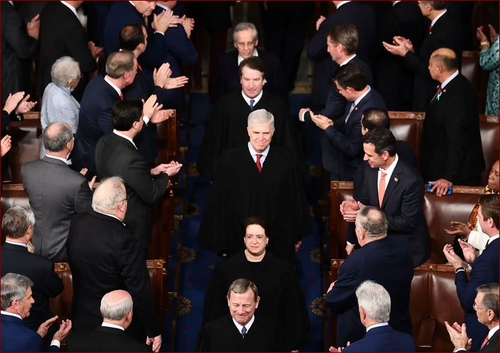NEXT WEEK, President Obama will be on Capitol Hill, appearing before a joint session of Congress for the annual ritual known as the State of the Union address. Amid the hoopla and pageantry — the partisan cheers and ovations, the shout-outs to honorees in the gallery, the approving nods or deprecating scowls from the vice president and House speaker — one dour anomaly will be hard to miss. Members of the Supreme Court will be sitting poker-faced in the front row, draped in their black robes and refraining from any applause or show of loyalty.
 Supreme Court Justices used to have more self-respect than to dance attendance on presidents delivering political exhortations. |
The Constitution directs the president to periodically "give to the Congress information of the State of the Union," and most presidents since Woodrow Wilson have delivered that "information" in a formal speech. But nothing in the Constitution requires the Supreme Court to be on hand for the performance, and there is no time-honored tradition that explains their presence. It wasn't until the late 1950s that justices began regularly showing up for State of the Union addresses. Nothing has been gained by the change, least of all admiration for the Supreme Court or confidence in its impartiality.
Justices used to have more self-respect than to dance attendance on presidents delivering political exhortations. Scholars Todd Peppers and Micheal Giles, in research published in 2012, show that of the 35 State of the Union addresses given between 1913 and 1964, members of the Supreme Court appear to have attended only seven. The speech frequently coincided with court hearings, and justices were rarely inclined to reschedule oral arguments to accommodate a presidential oration.
That changed in 1965, when the State of the Union moved to an evening time slot. Lyndon Johnson wanted a larger TV audience, and the justices may have found it hard to resist the allure of a national broadcast. Apparently they also found it hard to mask their political preferences. Peppers and Giles write that justices openly applauded many of LBJ's legislative pronouncements, in areas ranging from civil rights to budget cuts to US-Soviet trade. Only in the 1970s did the justices seem to realize that they shouldn't be hip-hip-hooraying controversial measures they might later have to rule on. They learned to sit impassively while the carnival went on around them.
"To the extent the State of the Union has degenerated into a political pep rally, I'm not sure why we are there," Chief Justice John Roberts admitted in 2010. "The image of having the members of one branch of government standing up, literally surrounding the Supreme Court, cheering and hollering while the court ... has to sit there expressionless, I think is very troubling."
It sure was troubling that year, when some of the "hollering" was incited by Obama's pointed criticism of the court itself. With six justices directly before him, the president denounced the recent ruling in Citizens United v. FEC, claiming it had "opened the floodgates for special interests, including foreign corporations," to sway US elections. ("Not true," Justice Samuel Alito was seen to murmur — a reaction many in the media ludicrously treated as a shocking breach of etiquette.)
Roberts may wonder "why we are there," yet he continues to attend State of the Union speeches. Several of his colleagues, on the other hand, have decided they have better things to do than sit in frozen silence during the partisan ovations and political showmanship.
Clarence Thomas says he stopped going because it became "very uncomfortable for a judge to sit there," adding that "there's a lot that you don't hear on TV — the catcalls, the whooping and hollering and under-the-breath comments." Antonin Scalia hasn't attended the speech since 1997. "It has turned into a childish spectacle," he remarks. "I don't want to be there to lend dignity to it." Alito, having learned the hard way that there is no percentage in having to "sit there like the proverbial potted plant," hasn't returned since 2010.
The State of the Union address gains nothing from the presence of black-clad jurists except a whiff of gravitas it doesn't merit. The heavens wouldn't fall if all the Supremes simply stopped taking part. In 1986 and 2000, Ronald Reagan and Bill Clinton delivered addresses that none of the justices attended. The nation survived — just as it survived the pre-TV era when the Supreme Court wasn't represented at the State of the Union pageant because it was focused on something more pressing.
Its job.
(Jeff Jacoby is a columnist for The Boston Globe).
-- ## --
Follow Jeff Jacoby on X (aka Twitter).
Discuss his columns on Facebook.
Want to read more? Sign up for "Arguable," Jeff Jacoby's free weekly email newsletter.

